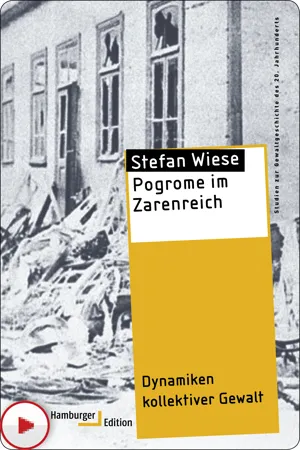
- 350 pages
- English
- ePUB (mobile friendly)
- Available on iOS & Android
About this book
"Ein Pogrom kann man nach Belieben machen – mit zehn Opfern oder mit zehntausend, ganz nach Wunsch."Fürst Sergej D. Urusov in der russischen Staatsduma, 1906Russland war das Land der Pogrome, so sah es zumindest die europäische Öffentlichkeit um 1900. Deshalb bürgerte sich auch in den meisten Sprachen das russische Wort "Pogrom" für diese Form von meist antijüdischer Gewalt ein. Aber was machte die Pogrome aus? Wer waren die Akteure? Geschahen sie spontan oder organisiert? Und warum war ihre Zahl gerade im Russischen Reich so hoch?Antworten findet Stefan Wiese in den Handlungen aller Beteiligten, also der Täter, der Opfer, der Zuschauer und der Vertreter der Staatsmacht. Jede Gruppe verfügte über spezifische Ressourcen und verfolgte eigene Ziele, jede Gruppe beobachtete die übrigen und handelte dementsprechend. Aus dieser Dynamik ergaben sich Situationen, die Gewalt ermöglichten oder verhinderten. Laut Stefan Wiese waren bei Judenpogromen Strategien und Ressourcen der Akteure wichtiger als das Erbe des Antisemitismus. Ein vergleichender Blick auf Pogromgewalt gegen Armenier, Deutsche und die Intelligenzija bestätigt das.Stefan Wiese zeigt, was Pogrome sind, wie sie beginnen, vollzogen werden und wie sie enden; er räumt mit Vorurteilen auf, kontextualisiert die Pogrome neu, betont die Kontingenz von Raum und Gelegenheit und untersucht das Verhalten der staatlichen Organe. Mit seinem Buch über eine spezifische Form kollektiver Gewalt in den letzten Jahrzehnten des Russischen Reiches liegt eine beeindruckende, analytisch und sprachlich herausragende Phänomenologie des Pogroms vor.
Frequently asked questions
- Essential is ideal for learners and professionals who enjoy exploring a wide range of subjects. Access the Essential Library with 800,000+ trusted titles and best-sellers across business, personal growth, and the humanities. Includes unlimited reading time and Standard Read Aloud voice.
- Complete: Perfect for advanced learners and researchers needing full, unrestricted access. Unlock 1.4M+ books across hundreds of subjects, including academic and specialized titles. The Complete Plan also includes advanced features like Premium Read Aloud and Research Assistant.
Please note we cannot support devices running on iOS 13 and Android 7 or earlier. Learn more about using the app.
Information
Table of contents
- Cover
- Titel
- Impressum
- Inhalt
- Einleitung
- 1 Pogrom als Improvisation
- 2 Gewalt als Epidemie
- 3 Gerüstet ins Pogrom
- 4 Einberufungspogrome
- 5 Vom Pogrom zum Massaker
- Schluss
- Anhang
- Zum Autor